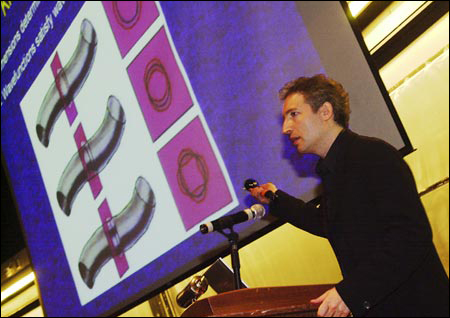Loeb physics lecturer explains string theory
Brian Greene delivers first of three talks as Morris Loeb lecturer

String theory – the idea that the universe is made up not of particles but of tiny vibrating strings – is in the midst of a second revolution that some physicists hope will lead to the long-sought single theory that explains how the universe functions, according to Columbia University Professor Brian Greene.
Greene opened his three-talk series on string theory Monday (April 26) afternoon in a crowded Science Center lecture hall. Greene is this year’s Morris Loeb lecturer, a position established in 1953 by the Physics Department.
Monday’s Loeb colloquium dealt with string theory in a general way, providing background for more technical discussions on Tuesday, when Greene spoke about “String Theory and Geometry” and today (April 29), when he will discuss “String Theory and Cosmology.”
Greene has won praise for his writings that make complex physics accessible, and he has been compared to astronomer Carl Sagan, who explained the cosmos to the general public in a series of books, lectures, and television programs.
Though a professor at Columbia, Greene has Harvard roots. He received his undergraduate degree from Harvard in 1984, and after receiving a doctorate from Oxford, returned to Harvard for postdoctoral research.
Physics Professor Andrew Strominger, who has collaborated with Greene, introduced him. He said Greene’s writings have been praiseworthy partly because Greene has a profound understanding of the subject and is able to translate it well.
Greene’s talk, “Searching for the Unified Theory” provided a general background of string theory, starting with Newton and progressing through Einstein to today’s research.
String theory’s proponents believe it may lead the way at last to the single unified theory that explains the workings of the universe. Quantum field theory explains three of nature’s four forces: the strong and weak forces at work on the atomic level, and the electromagnetic force, which works on the atomic level and at greater distances.
Gravity, which operates across large distances, is explained by the theory of general relativity. The need for two theories to explain how the universe works has sent physicists searching for another way of understanding the universe that would encompass all four forces.
String theory, which visualizes the smallest subatomic particles as tiny vibrating loops of string, may be one of those ways. According to string theory, the strings are the universe’s elemental material. They vibrate in different ways and can join and break apart to form different elemental particles that make up the universe.
Greene gave a brief history of the theory, from its roots in the late 1960s and early 1970s as a failed explanation for the strong force that binds an atomic nucleus, to its resurrection during a “first revolution” in the late 1970s and 1980s as an explanation for all four forces.
He gave an overview of the theory, which though it may explain all four forces presents physicists with other issues, such as the problem that it requires the universe to be made up of 11 dimensions: time, which physicists consider a dimension, and 10 spatial dimensions. Four of those dimensions are the ones we are familiar with, three spatial dimensions plus time. The other dimensions may be curled up and so small they’re invisible to current detection equipment.
Since 1995, Green said string theory has been in what he called a “second revolution” with research advancing rapidly. Still, he said, string theory is “very much a work in progress.”




